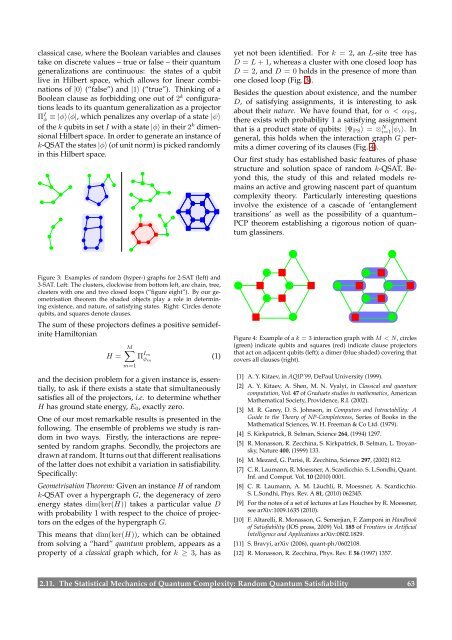Contents - Max-Planck-Institut für Physik komplexer Systeme
Contents - Max-Planck-Institut für Physik komplexer Systeme
Contents - Max-Planck-Institut für Physik komplexer Systeme
You also want an ePaper? Increase the reach of your titles
YUMPU automatically turns print PDFs into web optimized ePapers that Google loves.
classical case, where the Boolean variables and clauses<br />
take on discrete values – true or false – their quantum<br />
generalizations are continuous: the states of a qubit<br />
live in Hilbert space, which allows for linear combinations<br />
of |0〉 (“false”) and |1〉 (“true”). Thinking of a<br />
Boolean clause as forbidding one out of 2k configurations<br />
leads to its quantum generalization as a projector<br />
ΠI φ ≡ |φ〉〈φ|, which penalizes any overlap of a state |ψ〉<br />
of the k qubits in set I with a state |φ〉 in their 2k dimensional<br />
Hilbert space. In order to generate an instance of<br />
k-QSAT the states |φ〉 (of unit norm) is picked randomly<br />
in this Hilbert space.<br />
Figure 3: Examples of random (hyper-) graphs for 2-SAT (left) and<br />
3-SAT. Left: The clusters, clockwise from bottom left, are chain, tree,<br />
clusters with one and two closed loops (“figure eight”). By our geometrisation<br />
theorem the shaded objects play a role in determining<br />
existence, and nature, of satisfying states. Right: Circles denote<br />
qubits, and squares denote clauses.<br />
The sum of these projectors defines a positive semidefinite<br />
Hamiltonian<br />
H =<br />
M<br />
m=1<br />
Π Im<br />
φm<br />
and the decision problem for a given instance is, essentially,<br />
to ask if there exists a state that simultaneously<br />
satisfies all of the projectors, i.e. to determine whether<br />
H has ground state energy, E0, exactly zero.<br />
One of our most remarkable results is presented in the<br />
following. The ensemble of problems we study is random<br />
in two ways. Firstly, the interactions are represented<br />
by random graphs. Secondly, the projectors are<br />
drawn at random. It turns out that different realisations<br />
of the latter does not exhibit a variation in satisfiability.<br />
Specifically:<br />
Geometrisation Theorem: Given an instance H of random<br />
k-QSAT over a hypergraph G, the degeneracy of zero<br />
energy states dim(ker(H)) takes a particular value D<br />
with probability 1 with respect to the choice of projectors<br />
on the edges of the hypergraph G.<br />
This means that dim(ker(H)), which can be obtained<br />
from solving a “hard” quantum problem, appears as a<br />
property of a classical graph which, for k ≥ 3, has as<br />
(1)<br />
yet not been identified. For k = 2, an L-site tree has<br />
D = L + 1, whereas a cluster with one closed loop has<br />
D = 2, and D = 0 holds in the presence of more than<br />
one closed loop (Fig. 3).<br />
Besides the question about existence, and the number<br />
D, of satisfying assignments, it is interesting to ask<br />
about their nature. We have found that, for α < αPS,<br />
there exists with probability 1 a satisfying assignment<br />
that is a product state of qubits: |ΨPS〉 = ⊗ N i=1 |ψi〉. In<br />
general, this holds when the interaction graph G permits<br />
a dimer covering of its clauses (Fig. 4).<br />
Our first study has established basic features of phase<br />
structure and solution space of random k-QSAT. Beyond<br />
this, the study of this and related models remains<br />
an active and growing nascent part of quantum<br />
complexity theory. Particularly interesting questions<br />
involve the existence of a cascade of ‘entanglement<br />
transitions’ as well as the possibility of a quantum–<br />
PCP theorem establishing a rigorous notion of quantum<br />
glassiners.<br />
Figure 4: Example of a k = 3 interaction graph with M < N, circles<br />
(green) indicate qubits and squares (red) indicate clause projectors<br />
that act on adjacent qubits (left); a dimer (blue shaded) covering that<br />
covers all clauses (right).<br />
[1] A. Y. Kitaev, in AQIP’99, DePaul University (1999).<br />
[2] A. Y. Kitaev, A. Shen, M. N. Vyalyi, in Classical and quantum<br />
computation, Vol. 47 of Graduate studies in mathematics, American<br />
Mathematical Society, Providence, R.I. (2002).<br />
[3] M. R. Garey, D. S. Johnson, in Computers and Intractability: A<br />
Guide to the Theory of NP-Completeness, Series of Books in the<br />
Mathematical Sciences, W. H. Freeman & Co Ltd. (1979).<br />
[4] S. Kirkpatrick, B. Selman, Science 264, (1994) 1297.<br />
[5] R. Monasson, R. Zecchina, S. Kirkpatrick, B. Selman, L. Troyansky,<br />
Nature 400, (1999) 133.<br />
[6] M. Mezard, G. Parisi, R. Zecchina, Science 297, (2002) 812.<br />
[7] C. R. Laumann, R. Moessner, A. Scardicchio. S. L.Sondhi, Quant.<br />
Inf. and Comput. Vol. 10 (2010) 0001.<br />
[8] C. R. Laumann, A. M. Läuchli, R. Moessner, A. Scardicchio.<br />
S. L.Sondhi, Phys. Rev. A 81, (2010) 062345.<br />
[9] For the notes of a set of lectures at Les Houches by R. Moessner,<br />
see arXiv:1009.1635 (2010).<br />
[10] F. Altarelli, R. Monasson, G. Semerjian, F. Zamponi in Handbook<br />
of Satisfiability (IOS press, 2009) Vol. 185 of Frontiers in Artificial<br />
Intelligence and Applications arXiv:0802.1829.<br />
[11] S. Bravyi, arXiv (2006), quant-ph/0602108.<br />
[12] R. Monasson, R. Zecchina, Phys. Rev. E 56 (1997) 1357.<br />
2.11. The Statistical Mechanics of Quantum Complexity: Random Quantum Satisfiability 63
















